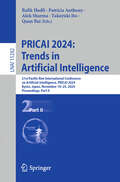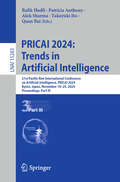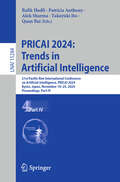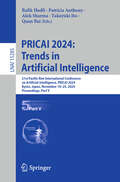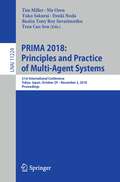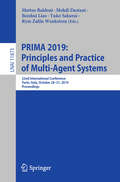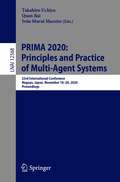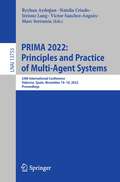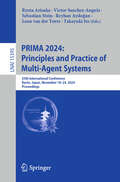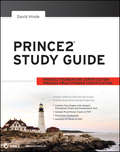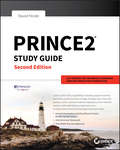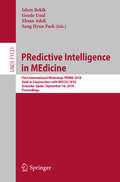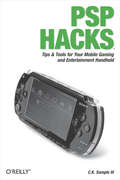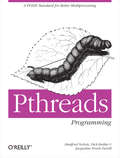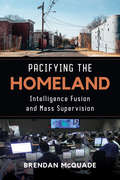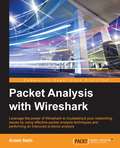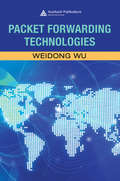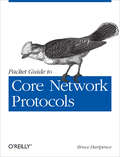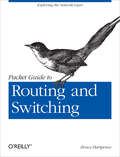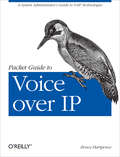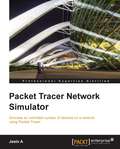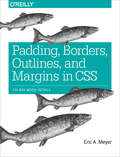- Table View
- List View
PRICAI 2024: 21st Pacific Rim International Conference on Artificial Intelligence, PRICAI 2024, Kyoto, Japan, November 18–24, 2024, Proceedings, Part II (Lecture Notes in Computer Science #15282)
by Patricia Anthony Quan Bai Takayuki Ito Rafik Hadfi Alok SharmaThe five-volume proceedings set LNAI 15281-15285, constitutes the refereed proceedings of the 21st Pacific Rim International Conference on Artificial Intelligence, PRICAI 2024, held in Kyoto, Japan, in November 18–24, 2024. The 145 full papers and 35 short papers included in this book were carefully reviewed and selected from 543 submissions. The papers are organized in the following topical sections: Part I: Machine Learning, Deep Learning Part II: Deep Learning, Federated Learning, Generative AI, Natural Language Processing, Large Language Models, Part III: Large Language Models, Computer Vision Part IV: Computer Vision, Autonomous Driving, Agents and Multiagent Systems, Knowledge Graphs, Speech Processing, Optimization Part V: Optimization, General Applications, Medical Applications, Theoretical Foundations of AI
PRICAI 2024: 21st Pacific Rim International Conference on Artificial Intelligence, PRICAI 2024, Kyoto, Japan, November 18–24, 2024, Proceedings, Part III (Lecture Notes in Computer Science #15283)
by Patricia Anthony Quan Bai Takayuki Ito Rafik Hadfi Alok SharmaThe five-volume proceedings set LNAI 15281-15285, constitutes the refereed proceedings of the 21st Pacific Rim International Conference on Artificial Intelligence, PRICAI 2024, held in Kyoto, Japan, in November 18–24, 2024. The 145 full papers and 35 short papers included in this book were carefully reviewed and selected from 543 submissions. The papers are organized in the following topical sections: Part I: Machine Learning, Deep Learning Part II: Deep Learning, Federated Learning, Generative AI, Natural Language Processing, Large Language Models, Part III: Large Language Models, Computer Vision Part IV: Computer Vision, Autonomous Driving, Agents and Multiagent Systems, Knowledge Graphs, Speech Processing, Optimization Part V: Optimization, General Applications, Medical Applications, Theoretical Foundations of AI
PRICAI 2024: 21st Pacific Rim International Conference on Artificial Intelligence, PRICAI 2024, Kyoto, Japan, November 18–24, 2024, Proceedings, Part IV (Lecture Notes in Computer Science #15284)
by Patricia Anthony Quan Bai Takayuki Ito Rafik Hadfi Alok SharmaThe five-volume proceedings set LNAI 15281-15285, constitutes the refereed proceedings of the 21st Pacific Rim International Conference on Artificial Intelligence, PRICAI 2024, held in Kyoto, Japan, in November 18–24, 2024. The 145 full papers and 35 short papers included in this book were carefully reviewed and selected from 543 submissions. The papers are organized in the following topical sections: Part I: Machine Learning, Deep Learning Part II: Deep Learning, Federated Learning, Generative AI, Natural Language Processing, Large Language Models, Part III: Large Language Models, Computer Vision Part IV: Computer Vision, Autonomous Driving, Agents and Multiagent Systems, Knowledge Graphs, Speech Processing, Optimization Part V: Optimization, General Applications, Medical Applications, Theoretical Foundations of AI
PRICAI 2024: 21st Pacific Rim International Conference on Artificial Intelligence, PRICAI 2024, Kyoto, Japan, November 18–24, 2024, Proceedings, Part V (Lecture Notes in Computer Science #15285)
by Patricia Anthony Quan Bai Takayuki Ito Rafik Hadfi Alok SharmaThe five-volume proceedings set LNAI 15281-15285, constitutes the refereed proceedings of the 21st Pacific Rim International Conference on Artificial Intelligence, PRICAI 2024, held in Kyoto, Japan, in November 18–24, 2024. The 145 full papers and 35 short papers included in this book were carefully reviewed and selected from 543 submissions. The papers are organized in the following topical sections: Part I: Machine Learning, Deep Learning Part II: Deep Learning, Federated Learning, Generative AI, Natural Language Processing, Large Language Models, Part III: Large Language Models, Computer Vision Part IV: Computer Vision, Autonomous Driving, Agents and Multiagent Systems, Knowledge Graphs, Speech Processing, Optimization Part V: Optimization, General Applications, Medical Applications, Theoretical Foundations of AI
PRIMA 2016: Princiles and Practice of Multi-Agent Systems
by Matteo Baldoni Amit K. Chopra Tran Cao Son Katsutoshi Hirayama Paolo TorroniThis book constitutes the refereed proceedings of the 19th International Conference on Principles and Practice of Multi-Agent Systems, PRIMA 2016, held in Phuket, Thailand, in August 22-26, 2016. The 16 revised full papers presented together with two invited papers, 9 short papers and three extended abstracts were carefully reviewed and selected from 50 submissions. The intention of the papers is to showcase research in several domains, ranging from foundations of agent theory and engineering aspects of agent systems, to emerging interdisciplinary areas of agent-based research.
PRIMA 2018: 21st International Conference, Tokyo, Japan, October 29-November 2, 2018, Proceedings (Lecture Notes in Computer Science #11224)
by Tim Miller Nir Oren Itsuki Noda Tran Cao Son Yuko Sakurai Bastin Tony Roy SavarimuthuThis book constitutes the refereed proceedings of the 21st International Conference on Principles and Practice of Multi-Agent Systems, PRIMA 2018, held in Tokyo, Japan, in October/November 2018. The 27 full papers presented and 31 short papers were carefully reviewed and selected from 103 submissions. PRIMA presents subjects in many application domains, particularly in e-commerce, and also in planning, logistics, manufacturing, robotics, decision support, transportation, entertainment, emergency relief and disaster management, and data mining and analytics.
PRIMA 2019: 22nd International Conference, Turin, Italy, October 28–31, 2019, Proceedings (Lecture Notes in Computer Science #11873)
by Matteo Baldoni Mehdi Dastani Yuko Sakurai Beishui Liao Rym Zalila WenksternThis book constitutes the refereed proceedings of the 22nd International Conference on Principles and Practice of Multi-Agent Systems, PRIMA 2019, held in Turin, Italy, in October 2019. The 25 full papers presented and 25 short papers were carefully reviewed and selected from 112 submissions. The papers presented at the PRIMA 2019 conference focus on the following topics: Logic and Reasoning, Engineering Multi-Agent Systems, Agent-Based Modeling and Simulation, Collaboration and Coordination, Economic Paradigms, Human-Agent Interaction, Decentralized Paradigms, and Application Domains for Multi-Agent Systems.
PRIMA 2020: 23rd International Conference, Nagoya, Japan, November 18–20, 2020, Proceedings (Lecture Notes in Computer Science #12568)
by Quan Bai Takahiro Uchiya Iván Marsá MaestreThis book constitutes the refereed proceedings of the 23rd International Conference on Principles and Practice of Multi-Agent Systems, PRIMA 2020, held in Nagoya, Japan, in November 2020. The 19 full papers presented and 13 short papers were carefully reviewed and selected from 50 submissions.Due to COVID-19, the conference was held online. The conference covers a wide range of ranging from foundations of agent theory and engineering aspects of agent systems, to emerging interdisciplinary areas of agent-based research.
PRIMA 2022: 24th International Conference, Valencia, Spain, November 16–18, 2022, Proceedings (Lecture Notes in Computer Science #13753)
by Reyhan Aydoğan Victor Sanchez-Anguix Jérôme Lang Natalia Criado Marc SerramiaThis book constitutes the refereed proceedings of the 23rd International Conference on Principles and Practice of Multi-Agent Systems, PRIMA 2020, held in hybrid mode in Valencia, Spain, in November 2022. The 31 full papers presented together with 15 short papers and 1 demo paper were carefully reviewed and selected from 100 submissions.The conference covers a wide range of ranging from foundations of agent theory and engineering aspects of agent systems, to emerging interdisciplinary areas of agent-based research.
PRIMA 2024: 25th International Conference, Kyoto, Japan, November 18–24, 2024, Proceedings (Lecture Notes in Computer Science #15395)
by Takayuki Ito Sebastian Stein Reyhan Aydoğan Victor Sanchez-Anguix Leon van der Torre Ryuta ArisakaThis book constitutes the refereed proceedings of the 25th International Conference on Principles and Practice of Multi-Agent Systems, PRIMA 2024, held in Kyoto, Japan, during November 18–24, 2024. The 23 full papers and 10 short papers presented in this volume were carefully reviewed and selected from 76 submissions. They are organized in the following topical sections: coordination and cooperation; market approaches; logics; learning; agent-based modelling and simulation; computational social choice.
PRINCE2 Study Guide
by David HindeEverything you need to be fully prepared to take the PRINCE2 Foundation and Practitioner examAs an internationally recognized certification which focuses on the Foundation and Practitioner levels along with being recommended by the Project Management Institute, the PRINCE2 accreditation gives a bolster to any resume.The author, David Hinde, has trained hundreds of individuals from many different backgrounds to prepare for the PRINCE2 exams. The book provides explanations of all parts of the PRINCE2 approach, lots of practical examples, and a whole range of mock examination questions to test your knowledge.Explains all the PRINCE2 themes, processes, principles, roles and management products for the very latest version of PRINCE2 (PRINCE2 2009 Edition)Features full coverage of all Foundation and Practitioner level exam objectivesPresents real-world scenarios, showing how the method is used in business and the public sectorIncludes challenging review questions and electronic flashcards to sharpen your knowledgeCovers tips and techniques for tackling the PRINCE2 accreditation examinations and shows you how and where to take the examsIncorporates over 300 sample Foundation-level and over 100 sample Practitioner-level questions, with answers and full explanationsContains a glossary of all PRINCE2 terminology and a quick reference to all the PRINCE2 management productsGives a web link to a set of on-line tools with more bonus examsPRINCE2 Study Guide covers all the necessary topics you need to know in order to confidently take the PRINCE2 Foundation and Practitioner exams.
PRINCE2 Study Guide: 2017 Update
by David HindeEverything you need to pass the PRINCE2 with flying colors The PRINCE2 Study Guide, Second Edition, offers comprehensive preparation for the latest PRINCE2 exam. Covering 100 percent of the exam objectives, this guide provides invaluable guidance that will help you master both the material and its applications; indeed, a practice-centered approach helps you “learn by doing” to help you internalize PRINCE2 concepts on a deeper level. Although the exam is heavily focused on detailed business process, this guide’s accessible writing and real-world approach make learning fun. Each chapter poses a common project challenge, and walks you through the solution based on essential PRINCE2 principles. A year of FREE access to electronic study aids allows you to study anywhere, at any time, and expert instruction throughout breaks complex topics down into easily-digestible concepts. The PRINCE2 exam is challenging, but thorough preparation is your best defense. Conceptual knowledge is important, but it isn’t enough—knowledge is only useful if you can apply it. This book is designed as your personal PRINCE2 coach: Master 100 percent of the PRINCE2 exam objectives Apply your knowledge to real-world workplace scenarios Test your understanding with challenging review questions Access sample questions, electronic flashcards, and other study aids PRINCE2 is globally recognized as one of the premier project management credentials; while less expansive than the PMP, the PRINCE2 is more intense and tightly focused on detailed business processes. Companies around the world are in need of qualified project management professionals to optimize processes and boost organizational performance—and the PRINCE2 certification puts you on the map as a validated professional. If you’re ready to take on your next challenge, the PRINCE2 Study Guide, Second Edition, is your ultimate companion for complete preparation.
PRedictive Intelligence in MEdicine: First International Workshop, PRIME 2018, Held in Conjunction with MICCAI 2018, Granada, Spain, September 16, 2018, Proceedings (Lecture Notes in Computer Science #11121)
by Gozde Unal Ehsan Adeli Islem Rekik Sang Hyun ParkThis book constitutes the refereed proceedings of the First International Workshop on PRedictive Intelligence in MEdicine, PRIME 2018, held in conjunction with MICCAI 2018, in Granada, Spain, in September 2018. The 20 full papers presented were carefully reviewed and selected from 23 submissions. The main aim of the workshop is to propel the advent of predictive models in a broad sense, with application to medical data. Particularly, the workshop will admit papers describing new cutting-edge predictive models and methods that solve challenging problems in the medical field.
PSP Hacks: Tips & Tools for Your Mobile Gaming and Entertainment Handheld
by C. K. Sample IIISure, it's just what you've been clamoring for: an ultra slick, portable version of the most popular console gaming system in the world. But Sony's new PlayStation Portable (PSP) isn't just a handheld gaming device. Beyond its killer graphics and spectacular widescreen LCD for unparalleled game play, it also sports wireless connectivity and a variety of multimedia features, including video, music, and digital photography. Your wildly versatile, endlessly powerful PSP practically begs you to hack and repurpose it to your liking.To save you the trouble and show you how to make the PSP do more than you ever imagined--and more than Sony ever intended--PSP Hacks is one succinct volume of 50 of the coolest, most useful, up-to-the-minute hacks for this amazing device. You'll learn how to open your PSP's hardware and what to safely plug into it. You'll explore and put to good use every hidden feature of the device. You'll be able to move all sorts of multimedia onto your PSP and find ways to extend its wireless capabilities. And you'll find out how to get the very best experience out of online game play.With PSP Hacks, you can accomplish a whole lot more than good gaming on the PSP. You'll quickly learn to surf the Web with a PSP, chat in IRC, and use the PSP to read web comics, ebooks, and RSS feeds. Other expert tips and tools allow you to sync an address book to your PSP, watch UMD movies, fool iTunes into thinking the PSP is an iPod Shuffle, and much more.The innovative hacks, tweaks, and how-tos in this essential guide make it easy to customize your PSP, take full advantage of features, capabilities, and functionality far beyond what's listed in the PSP user manual, and make your PSP perform countless tricks that only an all-in-one portable entertainment unit as remarkable and revolutionary as this one could.
PThreads Programming: A POSIX Standard for Better Multiprocessing
by Dick Buttlar Jacqueline Farrell Bradford NicholsComputers are just as busy as the rest of us nowadays. They have lots of tasks to do at once, and need some cleverness to get them all done at the same time.That's why threads are seen more and more often as a new model for programming. Threads have been available for some time. The Mach operating system, the Distributed Computer Environment (DCE), and Windows NT all feature threads.One advantage of most UNIX implementations, as well as DCE, is that they conform to a recently ratified POSIX standard (originally 1003.4a, now 1003.1c), which allows your programs to be portable between them. POSIX threads are commonly known as pthreads, after the word that starts all the names of the function calls. The standard is supported by Solaris, OSF/1, AIX, and several other UNIX-based operating systems.The idea behind threads programming is to have multiple tasks running concurrently within the same program. They can share a single CPU as processes do, or take advantage of multiple CPUs when available. In either case, they provide a clean way to divide the tasks of a program while sharing data.A window interface can read input on dozens of different buttons, each responsible for a separate task. A network server has to accept simultaneous calls from many clients, providing each with reasonable response time. A multiprocessor runs a number-crunching program on several CPUs at once, combining the results when all are done. All these kinds of applications can benefit from threads.In this book you will learn not only what the pthread calls are, but when it is a good idea to use threads and how to make them efficient (which is the whole reason for using threads in the first place). The authors delves into performance issues, comparing threads to processes, contrasting kernel threads to user threads, and showing how to measure speed. He also describes in a simple, clear manner what all the advanced features are for, and how threads interact with the rest of the UNIX system.Topics include:Basic design techniquesMutexes, conditions, and specialized synchronization techniquesScheduling, priorities, and other real-time issuesCancellationUNIX libraries and re-entrant routinesSignalsDebugging tipsMeasuring performanceSpecial considerations for the Distributed Computing Environment (DCE)
PaRappa the Rapper (Boss Fight Books)
by Mike SholarsIn the mid-90s, a Japanese prog rock star, an American visual artist, and their small team of collaborators made a colorful cartoon hip hop rhythm game that looked and played (and kicked! and punched!) like nothing else on the market. Initially dismissed by some as a curiosity, PaRappa the Rapper was a hit with players that would eventually sell millions of copies, receive two sequels, and inspire entire genres into being. And for author Mike Sholars, PaRappa left a lasting impact. Featuring exclusive interviews with creators Masaya Matsuura and Rodney Greenblat, original voice cast member Saundra Williams, and a medley of sharp game critics and music experts, Sholars&’ PaRappa the Rapper is equal parts recap, remix, and recollection. Sholars uses his love of hip hop and gaming to celebrate PaRappa&‘s unprecedented mechanics, art, humor, cultural specificity, and uplifting themes as he pairs energetic game history with personal memoir to explain how a game about a rapping dog helped him feel seen when he needed it the most. Funny, informative, and sincere, Sholars&’ book is a heartfelt reminder why we all gotta believe.
Pacifying the Homeland: Intelligence Fusion and Mass Supervision
by Brendan McQuadeThe United States has poured over a billion dollars into a network of interagency intelligence centers called “fusion centers.” These centers were ostensibly set up to prevent terrorism, but politicians, the press, and policy advocates have criticized them for failing on this account. So why do these security systems persist? Pacifying the Homeland travels inside the secret world of intelligence fusion, looks beyond the apparent failure of fusion centers, and reveals a broader shift away from mass incarceration and toward a more surveillance- and police-intensive system of social regulation. Provided with unprecedented access to domestic intelligence centers, Brendan McQuade uncovers how the institutionalization of intelligence fusion enables decarceration without fully addressing the underlying social problems at the root of mass incarceration. The result is a startling analysis that contributes to the debates on surveillance, mass incarceration, and policing and challenges readers to see surveillance, policing, mass incarceration, and the security state in an entirely new light.
Packet Analysis with Wireshark
by Anish NathLeverage the power of Wireshark to troubleshoot your networking issues by using effective packet analysis techniques and performing improved protocol analysis About This Book * Gain hands-on experience of troubleshooting errors in TCP/IP and SSL protocols through practical use cases * Identify and overcome security flaws in your network to get a deeper insight into security analysis * This is a fast-paced book that focuses on quick and effective packet captures through practical examples and exercises Who This Book Is For If you are a network or system administrator who wants to effectively capture packets, a security consultant who wants to audit packet flows, or a white hat hacker who wants to view sensitive information and remediate it, this book is for you. This book requires decoding skills and a basic understanding of networking. What You Will Learn * Utilize Wireshark's advanced features to analyze packet captures * Locate the vulnerabilities in an application server * Get to know more about protocols such as DHCPv6, DHCP, DNS, SNMP, and HTTP with Wireshark * Capture network packets with tcpdump and snoop with examples * Find out about security aspects such as OS-level ARP scanning * Set up 802.11 WLAN captures and discover more about the WAN protocol * Enhance your troubleshooting skills by understanding practical TCP/IP handshake and state diagrams In Detail Wireshark provides a very useful way to decode an RFC and examine it. The packet captures displayed in Wireshark give you an insight into the security and flaws of different protocols, which will help you perform the security research and protocol debugging. The book starts by introducing you to various packet analyzers and helping you find out which one best suits your needs. You will learn how to use the command line and the Wireshark GUI to capture packets by employing filters. Moving on, you will acquire knowledge about TCP/IP communication and its use cases. You will then get an understanding of the SSL/TLS flow with Wireshark and tackle the associated problems with it. Next, you will perform analysis on application-related protocols. We follow this with some best practices to analyze wireless traffic. By the end of the book, you will have developed the skills needed for you to identify packets for malicious attacks, intrusions, and other malware attacks. Style and approach This is an easy-to-follow guide packed with illustrations and equipped with lab exercises to help you reproduce scenarios using a sample program and command lines.
Packet Forwarding Technologies
by Weidong WuAs Internet traffic continues to grow exponentially, there is a great need to build Internet protocol (IP) routers with high-speed and high-capacity packet networking capabilities. The first book to explore this subject, Packet Forwarding Technologies explains in depth packet forwarding concepts and implementation technologies. It covers the
Packet Guide to Core Network Protocols
by Bruce HartpenceTake an in-depth tour of core Internet protocols and learn how they work together to move data packets from one network to another. With this updated edition, you’ll dive into the aspects of each protocol, including operation basics and security risks, and learn the function of network hardware such as switches and routers. New chapters examine the transmission control protocol (TCP) and user datagram protocol in detail.Ideal for beginning network engineers, each chapter in this book includes a set of review questions, as well as practical, hands-on lab exercises.You’ll explore topics including:Basic network architecture: how protocols and functions fit togetherThe structure and operation of the Ethernet protocolTCP/IP protocol fields, operations, and addressing used for networksThe address resolution process in a typical IPv4 networkSwitches, access points, routers, and components that process packetsTCP details, including packet content and client-server packet flowHow the Internet Control Message Protocol provides error messages during network operationsHow network mask (subnetting) helps determine the networkThe operation, structure, and common uses of the user datagram protocol
Packet Guide to Routing and Switching: Exploring the Network Layer
by Bruce HartpenceGo beyond layer 2 broadcast domains with this in-depth tour of advanced link and internetwork layer protocols, and learn how they enable you to expand to larger topologies. An ideal follow-up to Packet Guide to Core Network Protocols, this concise guide dissects several of these protocols to explain their structure and operation.This isn’t a book on packet theory. Author Bruce Hartpence built topologies in a lab as he wrote this guide, and each chapter includes several packet captures. You’ll learn about protocol classification, static vs. dynamic topologies, and reasons for installing a particular route.This guide covers:Host routing—Process a routing table and learn how traffic starts out across a networkStatic routing—Build router routing tables and understand how forwarding decisions are made and processedSpanning Tree Protocol—Learn how this protocol is an integral part of every network containing switchesVirtual Local Area Networks—Use VLANs to address the limitations of layer 2 networksTrunking—Get an indepth look at VLAN tagging and the 802.1Q protocolRouting Information Protocol—Understand how this distance vector protocol works in small, modern communication networksOpen Shortest Path First—Discover why convergence times of OSPF and other link state protocols are improved over distance vectors
Packet Guide to Voice over IP: A system administrator's guide to VoIP technologies
by Bruce HartpenceGo under the hood of an operating Voice over IP network, and build your knowledge of the protocols and architectures used by this Internet telephony technology. With this concise guide, you’ll learn about services involved in VoIP and get a first-hand view of network data packets from the time the phones boot through calls and subsequent connection teardown.With packet captures available on the companion website, this book is ideal whether you’re an instructor, student, or professional looking to boost your skill set. Each chapter includes a set of review questions, as well as practical, hands-on lab exercises.Learn the requirements for deploying packetized voice and videoUnderstand traditional telephony concepts, including local loop, tip and ring, and T carriersExplore the Session Initiation Protocol (SIP), VoIP’s primary signaling protocolLearn the operations and fields for VoIP’s standardized RTP and RTCP transport protocolsDelve into voice and video codecs for converting analog data to digital format for transmissionGet familiar with Communications Systems H.323, SIP’s widely used predecessorExamine the Skinny Client Control Protocol used in Cisco VoIP phones in networks around the world
Packet Tracer Network Simulator
by Jesin AA practical, fast-paced guide that gives you all the information you need to successfully create networks and simulate them using Packet Tracer. Packet Tracer Network Simulator is aimed at students, instructors, and network administrators who wish to use this simulator to learn how to perform networking instead of investing in expensive, specialized hardware. This book assumes that you have a good amount of Cisco networking knowledge, and it will focus more on Packet Tracer rather than networking.
Padding, Borders, Outlines, and Margins in CSS: CSS Box Model Details
by Eric A. MeyerThe ability to apply margins, borders, and padding to any web page element is one of the things that sets CSS so far above traditional markup. With this practical guide, you will not only learn how to use these properties to lay out your document, but also how to change and control the appearance of any element on the page.Short and sweet, this short book is an excerpt from the upcoming fourth edition of CSS: The Definitive Guide. When you purchase either the print or the ebook edition of Padding, Borders, Outlines, and Margins in CSS, you’ll receive a discount on the entire Definitive Guide once it’s released. Why wait? Learn how to bring life to your web pages now.Understand the CSS box model, including the way different properties relate to one anotherUse tricks for defining padding values, including inline element paddingExplore border width, style, and color, plus the use of border imagesLearn how to use outlines: presentational elements that won’t affect layoutDive into the use of margins, including the way top and bottom margins collapse
Padroneggiare la tecnologia Blockchain: Capire come si possa sfruttare la potenza della tecnologia Blockchain
by Jonathan S. WalkerPadroneggiare la tecnologia Blockchain per creare un ricco impero nei vostri investimenti State cercando il modo migliore per sfruttare la tecnologia Blockchain? Volete sapere come potete implementare al meglio la blockchain? Volete creare ricchezza utilizzando questa tecnologia? Vi presentiamo Padroneggiare la tecnologia BLOCKCHAIN! La vostra guida definitiva per sfruttare al meglio la potenza della tecnologia Blockchain. In questo libro imparerete: I migliori consigli per gli investimenti con Blockchain Migliori strategie di implementazione con Blockchain Cosa sono gli smart contact I pro e i contro della Blockchain E molto altro ancora... Prendi subito la tua copia di questo libro! Non perdere l'occasione di padroneggiare la tecnologia Blockchain! Scorri fino in cima e premi il pulsante "Compra ora" oggi stesso!
